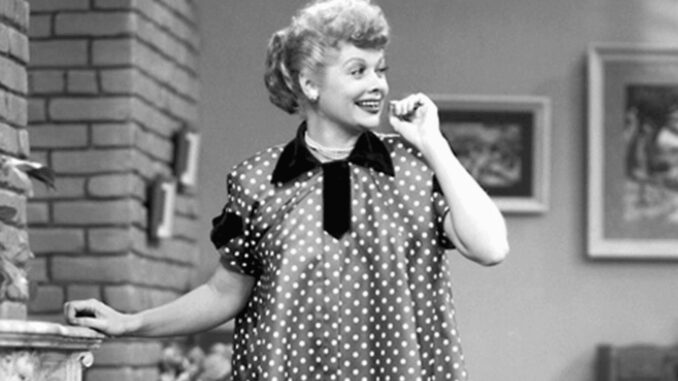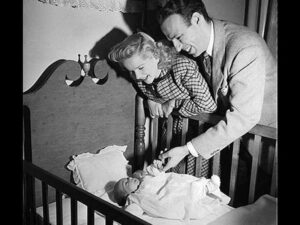
Imagine a world where pregnancy was too taboo for TV. That was the reality Lucille Ball and her husband, Desi Arnaz, faced in the 1950s. When Ball, one of Hollywood’s most beloved stars, discovered she was expecting, it created an unexpected challenge for their wildly popular show, I Love Lucy. Back then, showing a pregnant woman on television was unthinkable. Yet, against all odds, I Love Lucy went on to make history, challenging social norms and television standards. Let’s dive into the incredible journey of Lucille Ball’s pregnancy and how it nearly became too controversial for TV.
What Made Lucille Ball’s Pregnancy So Controversial?
In 1952, pregnancy was a topic you’d rarely discuss in public, let alone display on national television. For network executives, the thought of portraying pregnancy on screen was shocking, almost scandalous. There were strict censorship codes on what could be shown and said on TV, and pregnancy was seen as “inappropriate content.”
The Social Climate of the 1950s: Why Pregnancy Was Taboo
The 1950s was an era marked by conservative values. Television networks, governed by these values, aimed to portray a sanitized version of American life. Anything that even hinted at intimacy, such as pregnancy, was viewed as too suggestive. The idea that Lucy Ricardo—a character with millions of fans—would be visibly pregnant was an unsettling thought for the network heads.
CBS’s Reluctance: The Pushback Against a Pregnant Lucy

CBS, the network that aired I Love Lucy, was resistant to Lucille Ball’s pregnancy storyline. Executives feared that even mentioning the word “pregnant” on air would alienate audiences and sponsors. They weren’t just worried about the scenes or storyline but also about the potential backlash from conservative viewers.
The Role of Desi Arnaz in Overcoming Network Resistance
Desi Arnaz, Lucille Ball’s husband both on and off the screen, played a crucial role in persuading CBS to take the risk. Arnaz argued that the show should reflect real life and that audiences would support a storyline that mirrored Ball’s actual pregnancy. His persistence helped break through network resistance, paving the way for an iconic television moment.
The Compromise: “Expecting” Instead of “Pregnant”
One major compromise that allowed the storyline to proceed was linguistic. The term “pregnant” was deemed too explicit, so writers substituted it with “expecting.” By framing Lucy’s pregnancy this way, they could soften the impact and make the concept more acceptable to the audience.
The Writers’ Challenge: Crafting a Family-Friendly Pregnancy Plot
With approval finally granted, the show’s writers faced an unprecedented challenge: crafting a pregnancy storyline that adhered to strict censorship rules. They had to avoid any hint of how Lucy became pregnant, focusing instead on the excitement and humor surrounding the impending arrival of a baby.
Episode Planning: Balancing Comedy with Sensitivity

The pregnancy storyline needed to maintain the comedic essence of I Love Lucy while treating Lucy’s condition with sensitivity. This balancing act is showcased perfectly in episodes like “Lucy Is Enceinte,” where Lucy tries to find the perfect way to tell her husband, Ricky, that she’s “expecting.” The humor and tenderness in the scene struck a chord with audiences, making it one of the show’s most beloved moments.
Audience Reaction: A Positive Reception to the Pregnancy Storyline
Despite the initial network concerns, the audience loved the pregnancy storyline. Viewers were thrilled to see Lucy go through the same life stages as many of them, creating an emotional connection between the character and her fans. It marked a turning point, proving that audiences could accept more realistic portrayals of family life.
Breaking Boundaries: The First On-Screen Pregnancy in Television History
Lucy Ricardo’s pregnancy marked the first time a pregnant character was featured on a television show. This groundbreaking moment paved the way for future portrayals of pregnancy on TV. Lucille Ball’s courage to embrace her real-life experience on screen set a new standard in television storytelling.
The Episode That Made History: “Lucy Goes to the Hospital”
The iconic episode “Lucy Goes to the Hospital” aired on January 19, 1953, and attracted a record-breaking 44 million viewers—more than watched President Eisenhower’s inauguration the following day. The immense popularity of this episode underscored how invested fans were in Lucy’s journey and how much they valued the show’s authenticity.
Lucille Ball’s Legacy: Redefining TV Norms
Lucille Ball’s decision to depict her pregnancy on I Love Lucy went beyond entertainment; it challenged and redefined television norms. She set a precedent for future shows, proving that audiences could handle topics previously deemed controversial. This shift in television storytelling allowed for more authentic family representations, laying the foundation for generations of family-centered TV shows.
The Impact on Future Television: From Taboo to Normalcy
Thanks to Lucille Ball, what was once considered scandalous became a television staple. Shows like The Brady Bunch, Friends, and Modern Family would later feature pregnancy storylines without hesitation. I Love Lucy broke the ice, allowing more natural and relatable portrayals of family life on screen.
What This Milestone Means for Television Today
The choice to feature Lucy’s pregnancy has had a lasting effect, challenging creators to push boundaries. Today, audiences expect TV shows to reflect real-life experiences, a shift made possible by the groundwork I Love Lucy laid in the 1950s.
Cultural Shifts: How Lucille Ball Empowered Women on TV
Lucille Ball’s portrayal also served as an inspiration for women. She showed that it was possible to balance motherhood and a successful career. This representation provided a powerful message to women, encouraging them to embrace their own ambitions and life changes without fear of societal judgment.
Why Lucille Ball’s Decision Is Still Relevant Today
In a world where family life is an essential part of television storytelling, it’s easy to overlook the struggle that made this possible. Lucille Ball’s courage to bring her pregnancy to I Love Lucy still serves as a reminder that sometimes breaking boundaries is necessary to reflect real life.
Lucille Ball’s Bold Move: A Blueprint for Future Storytelling
By embracing her pregnancy and insisting it be included in I Love Lucy, Lucille Ball set a blueprint for how television could evolve. Her decision showcased the power of authenticity in storytelling and the importance of challenging societal norms.
Conclusion
Lucille Ball’s pregnancy on I Love Lucy wasn’t just a plot twist; it was a milestone in television history. Against network pressure and societal norms, she fought to bring her real-life experience to the screen, and in doing so, she changed TV forever. Her bold decision not only connected with audiences in a new way but also set a precedent that opened the door for more realistic, relatable storytelling in family-centered television. Even today, Lucille Ball’s legacy lives on as a beacon of progress and authenticity.
